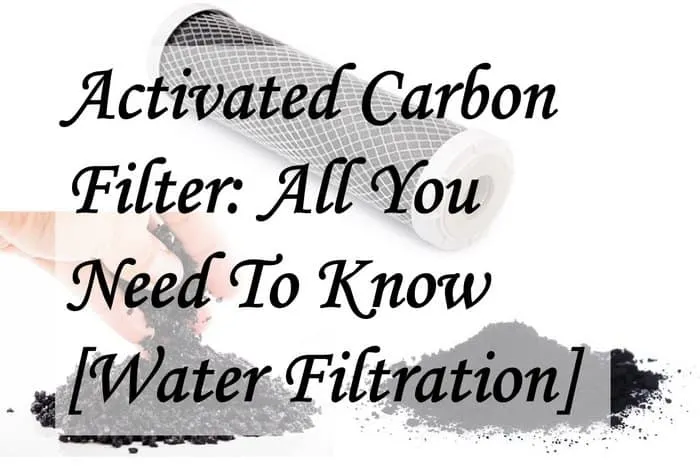What is activated carbon?
What is activated carbon filter?
How activated carbon filter works in water filtration system?
What makes activated carbon filter one of the most widely used water filter in the market?
Why you can easily see its shadow in other water filtration system?
In this post, let’s us understand more about this water filtration superstar!
What Is Activated Carbon?
Activated carbon is a positively charged carbon that attracts negatively charged contaminants and chemicals like chlorine.
It’s a more porous form of carbon which having a larger surface area for contaminants adsorption, make it a better choice for filtration than its base form.
The activated carbon is mostly made from the following three raw materials:
1. Bituminous Coal (Best compared to anthracite and lignite coal)
- Pros: High availability, higher mineral content, and low cost.
- Cons: Require mining, may affect water taste, less clean, vulnerable to pollutants, and has larger pores compared to others.
2. Wood
- Pros: Renewable, does not require mining, and can decolorize and remove the bad taste from water.
- Cons: Not easily available due to longer time to produced (trees take time to grow) and has limited filtration capability due to large pore size.
3. Coconut Shell
- Pros: Renewable, easily available, and has the highest density and porosity compared to other materials.
Out of these three, coconut shell is the most effective one in term of contaminants removal due to its micropores size, which makes it the best sourcing materials for activated carbon.
Until today, activated carbon is the most ideal way to get rid of bad tastes, smells, odors, and chemicals from water, which makes it one of the most effective filtration technologies that are widely used in the drinking water treatment industry.
It can be used alone (eg: faucet water filter, inline water filter, countertop water filter) or combine with other filtration technologies to filter more contaminants.
Filtration properties commonly specified are pore size and contaminant reduction objectives. Pore size typically is indicated in a micron rating, which represents the minimum size of particles to be mechanically filtered out of the product water.
In the market, the activated carbon filters for water come with different parameters such as capacity (gallons of filtered water before replacement), flow rate (measured in gallons per minute), operating pressure (psi), operating temperature, and pore size (micron rating, ranging from 50 to 0.5 microns nominal).
The micron rating indicates how small the particles it can mechanically filter out from the water.
That mean, it’s capable to block contaminants with size from 50 microns all the way down to 0.5 microns which make it the preferred choice from the majority of manufacturers and consumers.
Normal Carbon vs Activated Carbon
As activated carbon has finer porosity than a normal carbon, it’s more effective in removing contaminants in water.
Also, a positively charged activated carbon is performed much better in attracting negatively charged chemicals like Chlorine, make it an ideal material for filtering municipally treated water from house tap.
While for normal carbon, its usage is more on other applications like barbeque, cooking, absorb bad smells, odors, and cooking fumes, and more.
So for water filtration, activated carbon is the clear winner here.
What is Activated Carbon Filter
Activated Carbon filters are one of the most popular water filters used in various water filtration systems and applications.
They are either made from activated carbon powder (as an activated carbon block) or granular activated carbon (GAC).
Why Use Activated Carbon Filter?
So now you know what is activated carbon filter, but why you need to use activated carbon filter for your home?
Because the municipally treated water contains Chlorine chemicals, taste, and odor, and the activated carbon filter is the most effective filter to remove Chlorine chemical, gases, and odor from water.
Besides, the activated carbon filter can also effectively remove sediments, VOCs, and more contaminants in water.
What Does Activated Carbon Filter Remove and Reduce
The activated carbon filter for water is very effective in removing chlorine taste and odor, chemicals, organic contaminants, pesticides and herbicides that commonly found in tap water and well water.
In fact, one of the main reason that the activated carbon filter is widely incorporated in other water purification system is its strong capability in removing chlorine taste and bad smell.
Besides, the activated carbon filter can also adsorb all the particles and contaminants with a size that are larger than the size of its pores.
What Activated Carbon Filter Does Not Filter
Even though the activated carbon filter is one of the most used filtration technologies, it also comes with some limitation in term of filtration.
For instance, the activated carbon can’t remove dissolved solids like salts, heavy metals, and minerals in water and is not effective against microbiological and inorganic contaminants like coliform, arsenic, and bacteria.
It’s also not an efficient way to deal with sediments and large particles like sand, silt, rust, and stones.
Activated Carbon Block (ACB) vs Granular Activated Carbon (GAC)
Now you already know what is activated carbon, but do you know what is granular activated carbon?
Well, they are the same material in a different form.
There are two forms of activated carbon, which are the Activated Carbon Block (ACB) and the Granular Activated Carbon (GAC).

The former comes in a powder form (with sieve size from 0.045 to 0.18mm) while the later come in a granular form (with sieve size from 0.3 to 0.85 mm) .
Because the Activated Carbon Block (ACB) is finer than the Granular Activated Carbon (GAC), so it has a larger surface area and is more effective in removing chemicals and contaminants in water with shorter contact time at the same water flow rate.
Therefore, the Granular Activated Carbon (GAC) is mostly used to treat chlorine taste and odor, while Activated Carbon Block (ACB) go beyond and remove or reduce volatile organic compounds (VOCs), lead, cysts, particulates, and more contaminants.
Moreover, Activated Carbon Block produces significantly lower carbon fines than the Granular Activated Carbon (GAC) during the first use, which minimizes the initial flushing times.
While the smaller pore size of activated carbon block caused a slower flow rate compared to its granular counterpart, but at the same time, it minimized the risk for bacteria growth.
All these advantages make activated carbon block a better choice in water filtration application.
How Activated Carbon Filter Works
When contaminated water flows through the pores of activated carbon filter, all the impurities with size larger than the size of the pores get adsorb and accumulate on the large surface area of the activated carbon.
At the same time, the positively charged activated carbon attract all negatively charged chemicals like Chlorine to it.
Also, the carbon material itself will absorb the bad taste and smell from water that flowing through it.
The Advantages of Activated Carbon Filter
Here are the advantages of activated carbon filter:
- Effective against Chlorine taste and odor and chemicals
- Great in removing sediments
- Inexpensive
- Easily available in the market
The Disadvantages of Activated Carbon Filter
- Limited filtration capabilities
How To Use Activated Carbon Filter for Efficient Water Filtration
Despite activated carbon filter having many advantages in water filtration, it still needs to combine with other filtration technologies in order to work more effectively.
For instance, having a sediment filter (to get rid of large particles) before the activated carbon filter allows it to work on residual contaminants and chemicals effectively with a much longer lifespan.
And by working together with other filtration technologies like KDF media and Reverse Osmosis (which can remove dissolved solids, heavy metals, inorganic contaminants, and minerals), you get to overcome the filtration limitations by the activated carbon filter.
FAQs
1. What is activated carbon?
Activated carbon is a positively charged carbon that attracts negatively charged contaminants and chemicals like chlorine. It has a more porous form compared to normal carbon.
2. What is activated carbon filter?
Activated carbon filter is a filter cartridge used in water filtration system that are made from activated carbon material.
3. Is activated carbon filter harmful to human body?
No. Activated carbon filter is made from natural raw material that are not harmful to human body.
4. Is activated carbon for water filter effective in removing contaminants in water?
Yes. The porosity of activated carbon filter make it a great medium to block particles and contaminants in water. Its positvely charged surface will attract negatively charged chemical contaminants.
5. Why you should use activated carbon filter for your home?
Because it’s cheap, effective, and eco-friendly.
6. How Activated Carbon Filter Works?
Activated carbon filter physically block all the contaminants that have a larger size than it pores and absorbs contaminants with charges like Chlorine chemical.
Conclusion
So now you know what is activated carbon filter and how activated carbon filter work in removing harmful contaminants in water.
The activated carbon filter has been performing very well since the past, and still going strong in the water treatment industry.
Will it be replaced by other better option in the near future?
No one knows.
But that’s not what you need to concern about.
What you should care about is, have you got your water filter already?
Related Posts:


It’s great to know that the impurities in the water will get adsorbed by a water filter if I have it in my home. My water sometimes gets cloudy, and despite the fact that it’s still safe to drink, I still think that it’s healthier to have clear water. I think I’ll have a drinking water filtration system installed in my house so I can get clear water to drink in my home for free.
Yes, I’d highly recommend getting a great water filtration system for you and your family for health and safety concerns.
– Kitty, BrizFeel
Thank you for sharing your info. I really appreciate your efforts and I will be waiting for your further post thank you once again.|
Thanks!
Thanks for sharing such a good thought content, love it.
Glad you like it, thanks!
That’s what I was searching for, thanks!
You’re welcome!